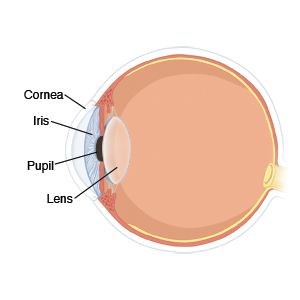You have a scratch or scrape (abrasion) on your cornea. The cornea is the protective covering in the front of the eye. It helps focus light on the retina. This sensitive area is very painful when injured. Your eye may be light sensitive and make tears frequently. Also, your vision may be blurry until the injury heals.
This part of the body heals quickly. You can expect the pain to go away within 24 to 48 hours. If the abrasion is large or deep, your health care provider may apply an eye patch, although this is not always done. Antibiotic ointment or eye drops may also be used to prevent infection.
Numbing drops may be used to relieve the pain temporarily so that your eyes can be examined., But these drops can’t be prescribed for home use because that would prevent healing and lead to more serious problems. Also, if you can’t feel your eye, there is a chance of accidentally injuring it further without knowing it.
Home care
-
A cold pack may be applied over the eye (or eye patch) for 20 minutes at a time to reduce pain. To make a cold pack, put ice cubes in a plastic bag that seals at the top. Wrap the bag in a clean, thin towel or cloth.
-
You may use acetaminophen or ibuprofen to control pain unless another pain medicine was prescribed. If you have chronic liver or kidney disease, talk with your health care provider before using these medicines. Also talk with your provider if you have ever had a stomach ulcer or gastrointestinal bleeding.
-
Rest your eyes and don’t read until symptoms are gone.
-
If you use contact lenses, don’t wear them until all symptoms are gone.
-
If your vision is affected by the corneal abrasion or if an eye patch was applied, don’t drive a motor vehicle or operate machinery until all symptoms are gone. You may have trouble judging distances using only one eye.
-
If your eyes are sensitive to light, try wearing sunglasses. Or stay indoors until symptoms go away.
Follow-up care
Follow up with your health care provider, or as advised.
-
If no patch was put on your eye and the pain continues for more than 48 hours, you should have another exam. Contact your provider to arrange this.
-
If your eye was patched and you were asked to remove the patch yourself, contact your provider if you still have pain after the patch is removed.
-
If you were given a return appointment for patch removal and re-exam, be sure to keep the appointment. Leaving the patch in place longer than advised could be harmful.
When to get medical advice
Contact your health care provider right away if any of the following occur:
-
Eye pain gets worse or does not get better after 24 hours
-
Discharge from the eye
-
Redness of the eye or swelling of the eyelids gets worse
-
Vision gets worse
-
Symptoms get worse after the abrasion has healed


